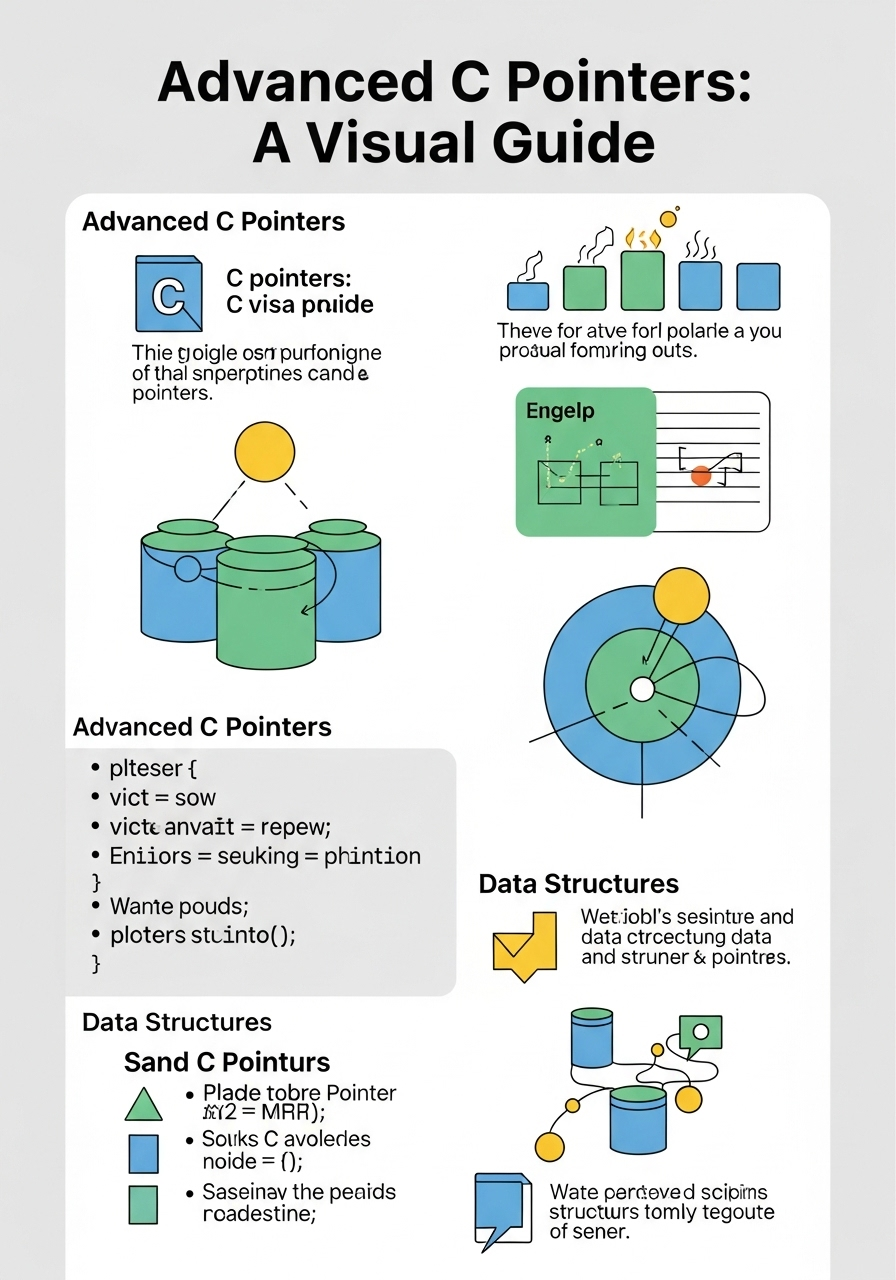
While often perceived as complex, a deep understanding of advanced pointer concepts is crucial for crafting high-performance data structures.
This article delves into the intricacies of C pointers, exploring how they can be leveraged to build efficient and optimized data structures that are critical for system programming and embedded systems.
From managing dynamic memory to enabling flexible data organization, pointers are the backbone of C’s power.
We’ll journey beyond the basics, uncovering the nuances of pointer arithmetic, double pointers, and void pointers, and their profound impact on performance.
We’ll also examine how these advanced pointer techniques are instrumental in the implementation of fundamental data structures like stacks, queues, and more complex structures, ensuring optimal memory utilization and execution speed.
Prepare to unlock the full potential of C as we explore the art of architecting high-performance data structures with advanced pointer techniques.
This journey will not only enhance your understanding of C but also equip you with the knowledge to write more efficient, robust, and scalable code.

Videos you see are added as random thoughts 💭 💭 💭.
Pointers: The Power of Memory
Pointers in C are not just variables; they are direct conduits to memory, allowing programmers to interact with hardware at a fundamental level.
This direct access is what gives C its reputation for speed and efficiency, especially when dealing with large datasets or resource-constrained environments.
But the true power of pointers emerges when we move beyond simple memory addresses and explore their advanced applications.
One such application is pointer arithmetic.
While it might sound like a complex mathematical concept, it’s quite intuitive in the context of memory.
When you perform arithmetic operations on a pointer,
you’re not just adding or subtracting a raw number;
you’re moving the pointer by a multiple of the size of the data type it points to.
For instance, if you have an `int` pointer and you increment it, the pointer moves forward by `sizeof(int)` bytes, effectively pointing to the next integer in memory.
This capability is invaluable for traversing arrays and other contiguous memory blocks with remarkable efficiency [1].
Then there are double pointers, also known as pointers to pointers.
Imagine a scenario where you need a function to modify the memory address held by a pointer in the calling function.
A single pointer passed by value won’t work, as only a copy of the address would be modified.
This is where double pointers shine.
By passing the address of the pointer itself,
the function can directly alter where the original pointer points, a technique frequently employed in dynamic memory allocation and linked data structures to manage nodes and their connections [1].
Finally, we encounter void pointers, the chameleons of the pointer world.
A void pointer, declared as `void`, is a generic pointer that can hold the address of any data type.
This flexibility makes them incredibly useful in situations where you need to write generic functions that can operate on different data types without knowing their specific type at compile time.
However, this power comes with a responsibility: before dereferencing a void pointer, it must be cast to the correct data type to ensure proper memory access and interpretation [1].
These advanced pointer concepts—pointer arithmetic, double pointers, and void pointers—are not merely academic curiosities.
They are the tools that enable C programmers to build highly optimized and efficient data structures, laying the groundwork for the performance gains that C is renowned for.
Understanding and mastering these concepts is a critical step towards architecting high-performance software.
Pointers and Data Structures: A Symbiotic Relationship
The true impact of advanced C pointers becomes evident when we explore their integral role in the construction and optimization of data structures.
Data structures are fundamental to organizing and storing data efficiently, and in C,
pointers are often the glue that binds them together, enabling dynamic resizing, flexible organization, and ultimately, high performance.
Consider the stack, a Last-In, First-Out (LIFO) data structure.
While a stack can be implemented using arrays, a pointer-based linked list implementation offers greater flexibility, especially when the maximum size of the stack is not known beforehand.
Each node in the linked list contains a pointer to the next node, allowing for dynamic allocation and deallocation of memory as elements are pushed onto or popped from the stack.
This dynamic nature, facilitated by pointers, prevents overflow issues and optimizes memory usage by allocating memory only when needed [1].
Similarly, the queue, a First-In, First-Out (FIFO) data structure, benefits immensely from pointer-based implementations.
A linked list-based queue, with pointers to both the front and rear of the queue, allows for constant-time enqueue and dequeue operations.
This efficiency is crucial in scenarios like operating system process scheduling or network packet management, where rapid processing of elements is paramount.
Pointers ensure that new elements can be added and old elements removed without the need for costly data shifting, which would be necessary in a fixed-size array implementation [1].
Beyond linear data structures, pointers are indispensable for more complex, non-linear structures like trees and graphs.
In a binary tree, for instance, each node typically contains pointers to its left and right children.
This pointer-based linkage allows for efficient traversal, insertion, and deletion of nodes, regardless of their physical location in memory.
The ability to dynamically link nodes through pointers is what gives trees their hierarchical flexibility and makes them suitable for applications like file systems or database indexing [2].
Hash tables, another cornerstone of high-performance computing, also rely heavily on pointers.
When collisions occur (multiple keys mapping to the same index), separate chaining, a common collision resolution technique, uses linked lists at each hash table index.
Here, pointers are used to link together all the elements that hash to the same location, ensuring efficient storage and retrieval even with a high number of collisions.
This blend of array-based indexing and pointer-based linked lists contributes to the hash table’s average O(1) time complexity for insertions, deletions, and lookups [1].
In essence, pointers provide the mechanism for dynamic memory management and flexible data relationships that are critical for building efficient and scalable data structures in C.
Without the precise control offered by pointers, many of the high-performance data structures we rely on would be significantly less efficient or even impossible to implement dynamically.
Special Types of Pointers: Navigating the Nuances
Beyond the fundamental types and their arithmetic, C offers several special categories of pointers, each with its own purpose and potential pitfalls.
Understanding these nuances is crucial for writing robust and error-free C code, especially when dealing with memory management and complex data structures.
First, we have the NULL pointer. A NULL pointer is a pointer that does not point to any valid memory location.
It is typically assigned the value `NULL` (or `0` or `nullptr` in C++).
The primary use of a NULL pointer is to indicate that a pointer variable is not currently pointing to any object or function.
This is incredibly useful for error checking, especially after memory allocation calls like `malloc`, where a `NULL` return value signifies a failed allocation.
Checking for `NULL` pointers before dereferencing them is a fundamental practice to prevent segmentation faults and ensure program stability [2].
Next, the void pointer, which we touched upon earlier, deserves a deeper look.
While its generic nature allows it to point to any data type, it cannot be directly dereferenced.
This means you cannot access the value it points to without first casting it to a specific data type.
This characteristic makes void pointers ideal for implementing generic functions,
such as a `memcpy` function that can copy data of any type, or a generic sorting algorithm that can sort arrays of different data types by using a comparison function pointer.
The flexibility of void pointers comes with the responsibility of careful type casting to avoid runtime errors [2].
Then there are wild pointers. These are pointers that have been declared but not initialized.
They contain garbage values, meaning they point to an arbitrary memory location.
- Attempting to dereference a wild pointer can lead to
- unpredictable behavior, including
- program crashes,
- data corruption,
- or security vulnerabilities,
as you might be writing to or reading from an unintended memory address.
Always initialize your pointers, even if it’s to `NULL`, to avoid the dangers of wild pointers [2].
Finally, we encounter dangling pointers.
A dangling pointer is a pointer that points to a memory location that has been deallocated (freed).
This often occurs after `free()` is called on dynamically allocated memory, but the pointer itself is not set to `NULL`.
If the program later attempts to dereference this dangling pointer, it can lead to undefined behavior, as the memory might have been reallocated for another purpose or become inaccessible.
To prevent dangling pointers, it’s a best practice to set a pointer to `NULL` immediately after freeing the memory it points to [2].
Mastering these special types of pointers is not just about avoiding errors; it’s about writing more robust, secure, and efficient C programs.
By understanding their behavior and implementing proper handling mechanisms, developers can harness the full power of C’s memory management capabilities without falling prey to common pointer-related pitfalls.
Conclusion
Advanced C pointers are more than just a feature of the language; they are a powerful paradigm that,
when understood and applied correctly, can unlock significant performance gains and enable the creation of highly efficient data structures.
From the precise memory manipulation offered by pointer arithmetic to the flexible data handling facilitated by double and void pointers, these concepts are foundational to mastering C for high-performance computing.
We’ve seen how pointers are not merely tools for memory access but are integral to the very architecture of dynamic data structures like stacks, queues, trees, and hash tables.
Their ability to manage memory dynamically and establish complex relationships between data elements is what allows these structures to operate with optimal efficiency, making them indispensable in areas ranging from operating systems to embedded systems and large-scale applications.
However, with great power comes great responsibility.
The nuances of special pointer types—NULL, void, wild, and dangling pointers—highlight the critical importance of careful memory management and defensive programming practices.
Ignoring these can lead to subtle bugs, memory leaks, and program instability.
By diligently initializing pointers, checking for NULL values, and setting pointers to NULL after deallocation, developers can mitigate these risks and write more reliable code.
In essence, mastering advanced C pointers is an ongoing journey that deepens a programmer’s understanding of how software interacts with hardware.
It’s about gaining fine-grained control over memory, which is the ultimate determinant of performance in many computing contexts.
By embracing these advanced concepts, you are not just writing C code; you are architecting high-performance solutions that stand the test of efficiency and reliability.
References
[1] Toğunçhan Düzgün, M. (2025, February 16).
Mastering Advanced Data Structures in C:
Pointers, Stacks, Queues, and Hash Tables*.
[2] GeeksforGeeks. (2025, July 26). *C Pointers*. [2]()
